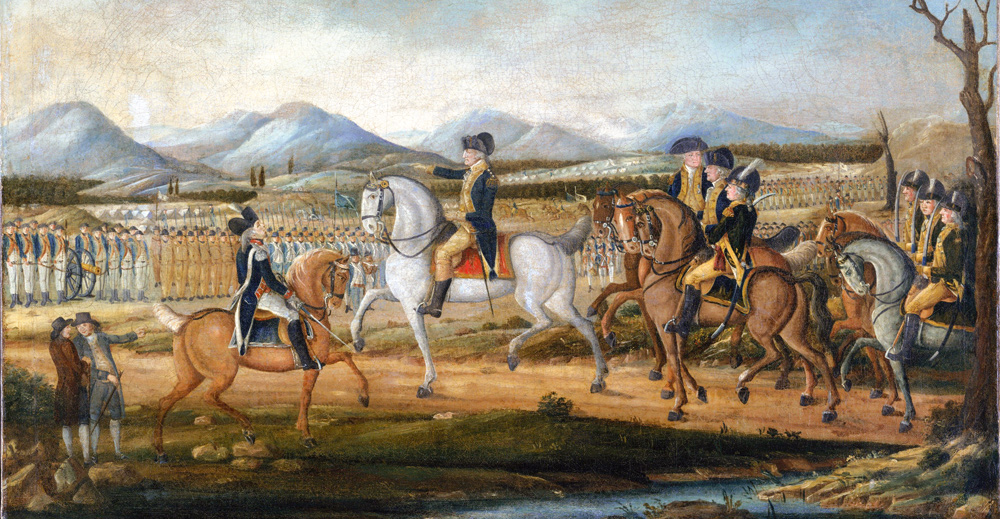Lewis travels to Pittsburgh passing through Fort Ashby and likely reaching Cumberland, Maryland. Perhaps his recollections of the area are like those of fellow Virginia Militia officer Dr. Robert Wellford.
Washington Reviewing the Western Army at Fort Cumberland, Maryland
Frederick Kemmelmeyer (1760–1821)
Gift of Edgar William and Bernice Chrysler Garbisch, 1963, Metropolitan Museum of Art, www.metmuseum.org/art/collection/search/11302. (cropped)
Lewis likely participated in the ceremonies surrounding President George Washington at Fort Cumberland in October 1794. According to Robert Wellford, “every regiment was drawn up in excellent order to receive him, & as he passed the line of Infantry he deliberately bowed to every officer individually. The Artillery at the same time announced his arrival.”[1]Robert Wellford, “A Diary Kept by Dr. Robert Wellford, of Fredericksburg, Virginia, during the March of the Virginia Troops to Fort Pitt (Pittsburgh) to Suppress the Whiskey Insurrection in … Continue reading
Whiskey Rebellion Recollections
Lewis likely became familiar with the taverns—what we would call today inns—as a 20-year-old lieutenant in the 1794 Whiskey Rebellion. At that time, fellow officer Robert Wellford left a favorable impression of a tavern in Fort Ashby, then known as Frankfort.
Thursday, 9th
Our reception at McAllisters was so disagreeable to the generality of his guests that the Squadron moved away very early, & rode thro’ the rain to Frankfort, 7 miles, where we had a most comfortable breakfast at McMeekins Tavern. In the vicinage of this town we found encamped the brigade of Militia commanded by Genl. Dark . . . .
—Robert Wellford[2]Robert Wellford, “A Diary Kept by Dr. Robert Wellford, of Fredericksburg, Virginia, during the March of the Virginia Troops to Fort Pitt (Pittsburg) to Suppress the Whiskey Insurrection in … Continue reading
Robert Wellford
Dr. Robert Wellford (1753–) came from England to serve as surgeon of the English First Battalion of Grenadiers. He replaced Dr. Gordon after the latter’s inhumane treatment of American prisoners was investigated by Sir William Howe. Dr. Wellford’s kind treatment of American prisoners gained him respect and friendship from many Americans and disdain from the British and their Hessian officers. He resigned his commission, and after the war, remained in Philadelphia. During the Whiskey Rebellion, he treated ill soldiers in the Virginia State Militia at the time Meriwether Lewis served in that campaign.[3]B.R.W., Jr. [Beverly R. Wellford, Jr., the grandson of Robert Wellford] in “A Diary Kept by Dr. Robert Wellford,” 1—2.
Experience the Lewis and Clark Trail
The Lewis and Clark Trail Experience—our sister site at lewisandclark.travel—connects the world to people and places on the Lewis and Clark Trail.
Plan a trip related to July 10, 1803:
- Harpers Ferry to Brownsville (Inspiration Trip)

Notes
| ↑1 | Robert Wellford, “A Diary Kept by Dr. Robert Wellford, of Fredericksburg, Virginia, during the March of the Virginia Troops to Fort Pitt (Pittsburgh) to Suppress the Whiskey Insurrection in 1794.” The William and Mary Quarterly 11, no. 1 (1902): p. 7, accessed 24 November 2022 from doi.org/10.2307/1915481. |
|---|---|
| ↑2 | Robert Wellford, “A Diary Kept by Dr. Robert Wellford, of Fredericksburg, Virginia, during the March of the Virginia Troops to Fort Pitt (Pittsburg) to Suppress the Whiskey Insurrection in 1794.” The William and Mary Quarterly 11, no. 1 (1902): p. 6, accessed 24 November 2022 from doi.org/10.2307/1915481. |
| ↑3 | B.R.W., Jr. [Beverly R. Wellford, Jr., the grandson of Robert Wellford] in “A Diary Kept by Dr. Robert Wellford,” 1—2. |

